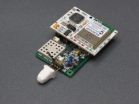(Press-News.org) CORVALLIS, Ore. – Nuclear engineers at Oregon State University have developed a small, portable and inexpensive radiation detection device that should help people all over the world better understand the radiation around them, its type and intensity, and whether or not it poses a health risk.
The device was developed in part due to public demand following the nuclear incident in Fukushima, Japan, in 2011, when many regional residents were unsure what level of radiation they were being exposed to and whether their homes, food, environment and drinking water were safe.
Devices that could provide that type of information were costly and not readily available to the general public, and experts realized there was a demand for improved systems that could provide convenient, accurate information at a low cost. The new system should eventually be available for less than $150.
Findings on the new technology were just published in Nuclear Instruments and Methods in Physics Research, a professional journal. The systems are not yet available for commercial sale.
Beyond the extremely rare occasion of a radiological or nuclear incident, the new technology may also help interested consumers learn more about the world of radiation surrounding us, the constant exposure they receive – everything from a concrete wall to the air we breathe, soils around us or a granite kitchen counter top – and how to understand routine radiation exposure as a part of normal life.
"With a device such as this, people will be better able to understand and examine the environment in which they live," said Abi Farsoni, an associate professor of nuclear engineering in the OSU College of Engineering. "Radiation is a natural part of our lives that many people don't understand, but in some cases there's also a need to measure it accurately in case something could be a health concern. This technology will accomplish both those goals."
Of some interest, the researchers said, is that the technology being used in the new device provides measurements of radiation that are not only less expensive but also more efficient and accurate than many existing technologies that cost far more. Because of that, the system may find use not just by consumers but in laboratories and industries around the world that deal with radioactive material. This could include scientific research, medical treatments, emergency response, nuclear power plants or industrial needs.
The system is a miniaturized gamma ray spectrometer, which means it can measure not only the intensity of radiation but also identify the type of radionuclide that is creating it. Such a system is far more sophisticated than old-fashioned "Geiger counters" that provide only minimal information about the presence and level of radioactivity.
"The incident at Fukushima made us realize that many people wanted, but were not able to afford, a simple technology to tell them if their environment, food or water was safe," Farsoni said. "This portable system, smaller than a golf ball, can do that, and it will also have wireless connectivity so it could be used remotely, or connected to the Internet."
The system combines digital electronics with a fairly new type of "scintillation detector" that gives it the virtues of small size, durability, operation at room temperature, good energy resolution, low power consumption and light weight, while being able to measure radiation levels and identify the radionuclides producing them.
Various models may be developed for different needs, researchers said, one of which might be the ability to measure radon gas and check homes with possible concerns for that type of radiation exposure, which can sometimes come from soils, rocks, concrete walls or foundations.
"There are a lot of misconceptions by many people about radioactivity and natural background radiation, and technology of this type may help address some of those issues," Farsoni said. "Sometimes, there are also real concerns, and the device will be able to identify them. And of some importance to us, we want the technology to be very simple and affordable so anyone can obtain and use it."
The new device, called a "MiniSpec," will ultimately be commercialized after final development is completed, researchers said.
INFORMATION:
Sophisticated radiation detector designed for broad public use
2014-07-10
ELSE PRESS RELEASES FROM THIS DATE:
'Mississippi Baby' now has detectable HIV, researchers find
2014-07-10
The child known as the "Mississippi baby"—an infant seemingly cured of HIV that was reported as a case study of a prolonged remission of HIV infection in The New England Journal of Medicine last fall—now has detectable levels of HIV after more than two years of not taking antiretroviral therapy without evidence of virus, according to the pediatric HIV specialist and researchers involved in the case.
"Certainly, this is a disappointing turn of events for this young child, the medical staff involved in the child's care, and the HIV/AIDS research community," said NIAID ...
Your next Angry Birds opponent could be a robot
2014-07-10
With the help of a smart tablet and Angry Birds, children can now do something typically reserved for engineers and computer scientists: program a robot to learn new skills. The Georgia Institute of Technology project is designed to serve as a rehabilitation tool and to help kids with disabilities.
The researchers have paired a small humanoid robot with an Android tablet. Kids teach it how to play Angry Birds, dragging their finger on the tablet to whiz the bird across the screen. In the meantime, the robot watches what happens and records "snapshots" in its memory. ...
It's Your Game ... Keep It Real reduces dating violence among minority youth
2014-07-10
HOUSTON – (July 10, 2014) – New research from The University of Texas Health Science Center at Houston (UTHealth) shows that It's Your Game…Keep it Real (IYG), a health education program designed to delay sexual behavior and promote healthy dating relationships, can significantly reduce dating violence behaviors among minority youth.
According to the Centers for Disease Control and Prevention, 10 percent of high school youth are victims of physical dating violence and other studies suggest that more than 20 percent are victims of emotional dating violence. Previous studies ...
NOAA, partners predict significant harmful algal bloom in western Lake Erie this summer
2014-07-10
NOAA and its research partners predict that western Lake Erie will have a significant bloom of cyanobacteria, a toxic blue-green algae, during the 2014 bloom season in late summer. However, the predicted bloom is expected to be smaller than last year's intense bloom, and considerably less than the record-setting 2011 bloom.
Bloom impacts will vary across the lake's western basin and are classified by an estimate of both its concentration and how far it spreads.
Harmful algal blooms (HABs) were common in western Lake Erie between the 1960s and 1980s. After a lapse of ...
CNIO scientists develop technology to redirect proteins towards specific areas of the genome
2014-07-10
The Spanish National Cancer Research Centre (CNIO) Macromolecular Crystallography Group has managed to reprogramme the binding of a protein called BuD to DNA in order to redirect it towards specific DNA regions. Guillermo Montoya, the researcher who led the study, says the discovery: "will allow us to modify and edit the instructions contained in the genome to treat genetic diseases or to develop genetically-modified organisms." The study is published in the journal Acta Crystallographica, Section D: Biological Crystallography.
The possibility of making à la carte modifications ...
New technology reveals insights into mechanisms underlying amyloid diseases
2014-07-10
Amsterdam, NL, 10 July 2014 – Amyloid diseases, such as Alzheimer's disease, type 2 diabetes, cataracts, and the spongiform encephalopathies, all share the common trait that proteins aggregate into long fibers which then form plaques. Yet in vitro studies have found that neither the amylin monomer precursors nor the plaques themselves are very toxic. New evidence using two-dimensional infrared (2D IR) spectroscopy has revealed an intermediate structure during the amylin aggregation pathway that may explain toxicity, opening a window for possible interventions, according ...
What you eat may affect your body's internal biological clock
2014-07-10
Food not only nourishes the body but also affects its internal biological clock, which regulates the daily rhythm of many aspects of human behavior and biology. Researchers reporting in the Cell Press journal Cell Reports provide new insights into how adjusting the clock through dietary manipulation may help patients with various conditions and show that insulin may be involved in resetting the clock.
An internal biological or 'circadian' clock plays an important role in preferred sleep times, times of peak alertness, and the timing of certain physiological processes. ...
Mediterranean fish stocks show steady decline
2014-07-10
While careful management has helped stabilize or even improve the state of fisheries resources in some parts of Europe, the situation in the Mediterranean has deteriorated over the past 20 years. In a new report evaluating nine fish species reported in the Cell Press journal Current Biology on July 10, scientists call for stringent monitoring of Mediterranean fishing activities, better enforcement of fisheries regulations, and advanced management plans in Mediterranean waters.
Their data show that the fishing pressure in the Mediterranean intensified continuously from ...
Chimpanzee intelligence depends on genes
2014-07-10
Some chimpanzees are smarter than others, and about half of that variation in intelligence depends on the genes that individuals carry and pass on from one generation to the next. The findings reported in the Cell Press journal Current Biology on July 10 show that those genetic differences will be key to understanding the cognitive abilities of primates and their evolution over time.
"As is the case in humans, genes matter when it comes to cognitive abilities in chimpanzees," says William Hopkins of the Yerkes National Primate Research Center. "It doesn't mean that they ...
Hunger for vegetable oil means trouble for Africa's great apes
2014-07-10
The vegetable oil found in your popcorn or soap might not be ape friendly, and the situation appears likely to get even worse, according to an analysis in the Cell Press journal Current Biology on July 10.
The growing demand for vegetable oil has already led to the conversion of Southeast Asian forest into oil palm plantations, bringing trouble for orangutans in particular. If guidelines are not put in place very soon, researchers say the spread of those large-scale industrial plantations from Asia into Africa will be bad news for great apes there as well.
"The first ...






